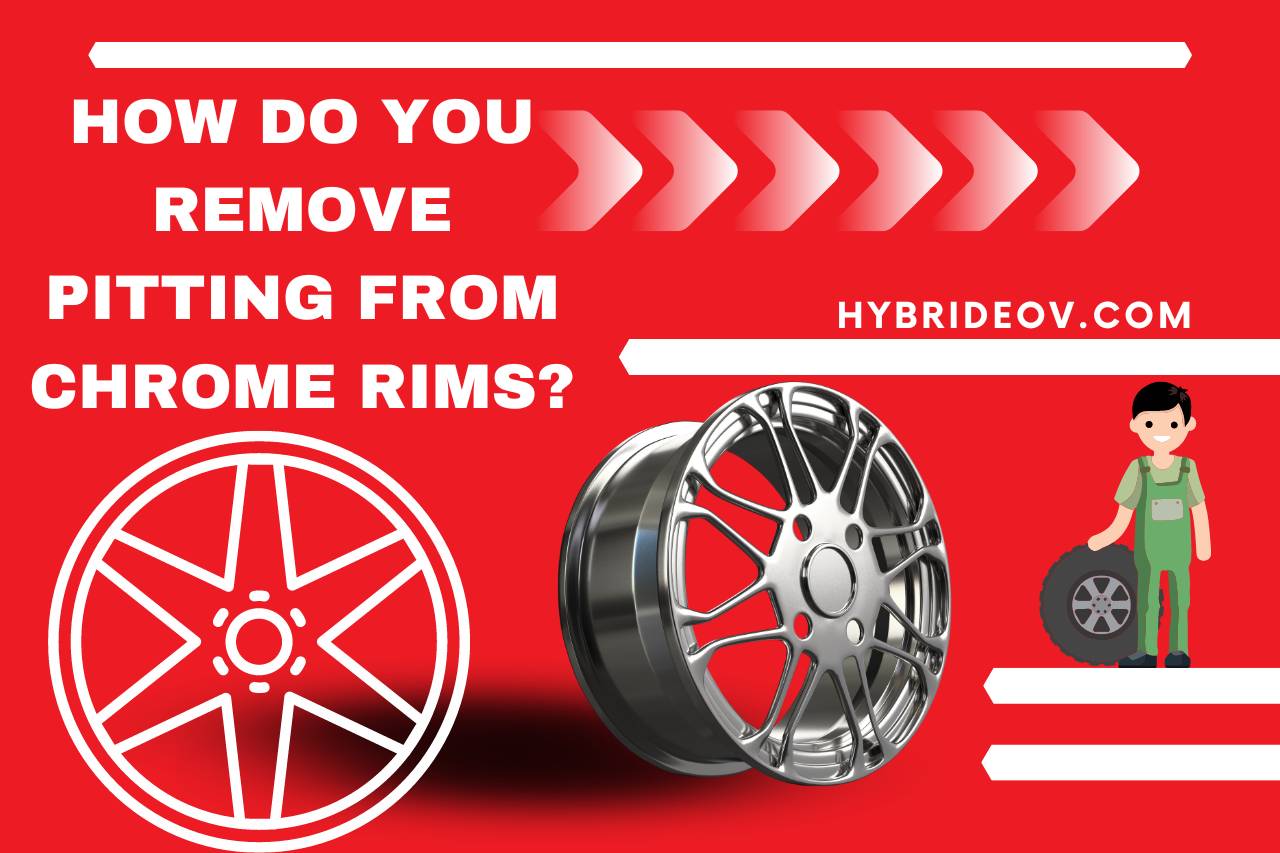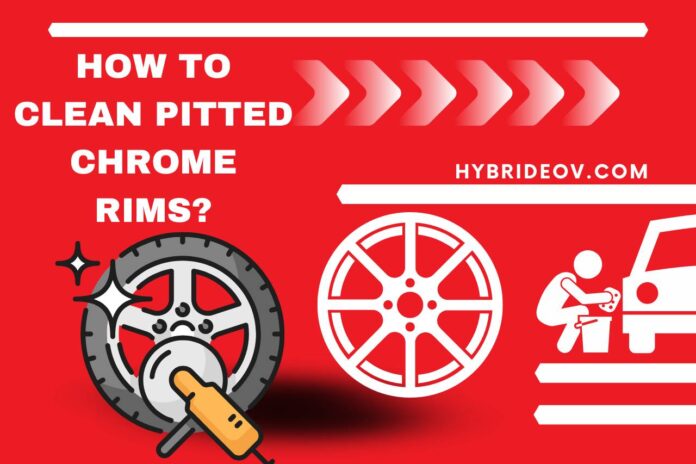Everyone enjoys a car with gleaming chrome rims. As a consequence, chrome is a prevalent option among the majority of drivers. The material in question quickly loses its luster as it begins to pit, which constitutes one of the most typical drawbacks of chrome. The positive thing is that you can repair and clean pitted chrome to restore your rims to like-new condition. However, you need to get started as soon as you see the rims changing appearance; otherwise, you may be unable to repair it if you wait too long. So, How to clean pitted chrome rims?
The best option is to comply with the most effective advice concerning how to clean pitted chrome rims.
What Causes Chrome Rims to Become Pitted?
Chrome rims are prone to rust, especially when exposed to harsh weather or road salt. Corrosion happens when the protective chrome plating on the rims wears away, enabling moisture and oxygen to reach the underlying metal. This may result in pitting over time.
Small stones, gravel, and other debris kicked up by the tires can produce minor impacts on the rims’ surface. These impacts, especially if the rims are not adequately covered or if the impacts are frequent, can eventually cause pits or small dents in the chrome plating.
Metal particles and other abrasive components in the brake dust can collect on the rims over time. If not cleaned regularly, dust can react with the chrome plating, pitting and deteriorating it.
Using harsh or abrasive cleansers, brushes, or sponges on chrome rims can harm the protective chrome layer and make them more prone to pitting.
Furthermore, failing to perform routine cleaning and maintenance might let pollutants to accumulate and contribute to pitting.
Certain chemicals, such as wheel cleaners, strong acids, and alkaline compounds, may come into contact with chrome plating and cause pitting or corrosion.
How Can I Visually Inspect Chrome Rims for Pitting?
Wash the rims to remove any dirt, grime, using a nonabrasive chrome cleaner and a soft cloth or sponge to clean the rims. Sufficient lighting will make it easier to spot any evidence of pitting.
Examine the whole surface of each rim. Pay special attention to regions where pitting is more likely to form, which includes the rim’s front face and edges.
Pitting frequently manifests itself as small, round or irregularly shaped pits or indentations in the chrome plating. Run your fingers lightly over the rims’ surface to check for rough areas or abnormalities.
Pitting can cause a rough or uneven texture on the chrome. Examine the surface of the rim for reflections.
Smooth, undistorted reflections indicate a well-maintained, pitting-free surface. If you detect distorted or wavy reflections, this could be a sign of pitting or damage to the chrome plating.
Perform the inspection on each rim separately because they may not be affected similarly.
Can Pitted Chrome Rims be Restored to Their Original Condition?
Pitted chrome rims can be repaired to some extent, depending on the severity of the pitting and the rims’ condition. Begin by cleaning the rims thoroughly to eliminate any dirt or debris. Then, carefully buff the rims’ surface using a chrome-specific polish or metal polish.
This can aid in reducing the number of tiny pits and restore shine. Work in small circular motions with a soft cloth or a polishing pad. Repeat the procedure as needed.
Chrome restoration kits on the market comprise specific products and tools for removing surface pitting and restoring the chrome finish. Specialized cleaners, polishes, and applicators are frequently included in these packages. For optimum results, follow the directions included in the kit.
If the pitting is extensive or DIY approaches fail to deliver satisfactory results, professional re-chroming services may be considered.
Rechroming entails removing the currently in-place chrome plating and putting in a fresh chrome layer. This method can efficiently restore the rims to their former state.
Severe or severe pitting can beble, and the restored rims may not be exactly as they were. Regular maintenance and good care following restoration can help extend the rims’ lifespan and reduce the chance of new pitting.
What are the Potential Risks of Cleaning Pitted Chrome Rims?
Pitted chrome rims have already become damaged, and utilizing vigorous cleaning methods or harsh chemicals might exacerbate the problem. Abrasive cleaners, harsh brushes, or scouring pads can scratch or remove the residual chrome plating, highlighting the pitting and causing further damage.
Some cleansers, particularly those containing strong acids or alkalis, can react with the chrome plating and aggravate pitting or corrosion. These chemical reactions can cause rim yellowing, etching, or additional degradation.
Certain cleaners could contain harsh chemicals that, when rinsed, might be hazardous to the environment. Using ecologically friendly cleaning chemicals and carefully disposing of any cleaning residues is critical.
To mitigate these dangers, use mild, nonabrasive cleansers designed specifically for chrome surfaces. Strong acids, alkaline compounds, and harsh chemicals should be avoided.
Use soft rags, sponges, or gentle brushes to clean the rims. Use abrasive materials or instruments to avoid additional deterioration of the chrome plating. Before applying any new cleaning product to the entire surface, test it on a small, inconspicuous rim portion.
This helps to guarantee the cleaner does not react negatively to the chrome plating.
After washing, thoroughly rinse the rims with clean water to remove any cleaning residue. If you have any questions about the best cleaning methods or products, speak with a rim cleaning or restoration specialist.
Can I Remove Pitting from Chrome Rims Using Household Items?
Eliminating pitting on chrome rims with common household supplies can be difficult since most household goods lack the specialized qualities required to handle pitting successfully.
Baking soda has moderate abrasive qualities that can aid in the reduction of small pits, produce a thick paste and apply in the areas. Rinse and dry the rims well with water.
Massage the pitted areas with a soft cloth or sponge soaked in white vinegar. Vinegar’s modest acidity may aid in the dissolution of minor surface corrosion or mineral deposits that might contribute to pitting. Rinse and dry the rims well with water.

How Do you Remove Pitting from Chrome Rims?
Clean the rims well with a light chrome cleaner or a mixture of mild dish soap and water. Remove any dirt, filth, or brake dust accumulated around the pitted areas. Rinse and completely dry the rims with water.
Determine the depth and breadth of the pitting. Superficial pitting with unbroken chrome plating is more likely to respond effectively to restoration efforts. Deeper pitting may necessitate more extreme precautions. Gently rub the pitted areas with a chrome-specific or fine metal polish.
Apply the polish gently circularly with a soft cloth or polishing pad. This can assist in reducing the visibility of tiny pits and restoring some shine. Follow the instructions for the individual polish you’re using.
You can attempt a chrome filler or compound if the pitting is serious enough. These materials are intended to fill in pits and level out the surface. Apply the filler or compound to the pitted areas according to the instructions by the manufacturer, and then buff it lightly with a soft cloth or pad.
This procedure may aid in the improvement of the appearance of deeper pits. Rechroming entails removing the old chrome plating and replacing it with a new coating, effectively returning the rims to their previous condition. Professional interventions are particularly recommended for deep or severe pitting.
How Often should I Clean and Maintain My Chrome Rims to Prevent Pitting?
Clean your chrome rims every month or more frequently if exposed to road salt, excessive grime, or other impurities.
Use a moderate chrome cleanser or a light dish soap and water combo. Scrub the rims gently with a soft cloth, sponge, or nonabrasive brush. After cleaning, properly rinse them with water and completely dry them.
Metal particles in brake dust can be very damaging to chrome rims. It is critical to remove brake dust regularly to avoid it interacting with the chrome and producing pitting or corrosion.
Clean the rims with a wheel brush or a soft cloth to remove brake dust buildup. Abrasive equipment and aggressive chemicals that can damage the chrome plating should be avoided.
Watch this one,
Video Credits – ZACPAC
You May Also Like




